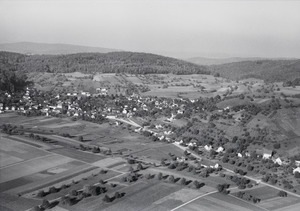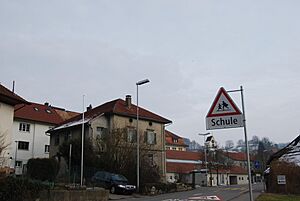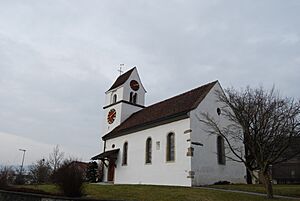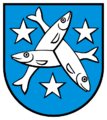Egliswil facts for kids
Quick facts for kids
Egliswil
|
||
|---|---|---|
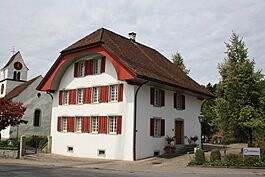
Gemeindehaus (the community house)
|
||
|
||
| Country | Switzerland | |
| Canton | Aargau | |
| District | Lenzburg | |
| Area | ||
| • Total | 6.29 km2 (2.43 sq mi) | |
| Elevation | 470 m (1,540 ft) | |
| Population
(Dec 2020 )
|
||
| • Total | 1,484 | |
| • Density | 235.93/km2 (611.1/sq mi) | |
| Postal code |
5704
|
|
| Surrounded by | Ammerswil, Dintikon, Lenzburg, Seengen, Seon, Villmergen | |
Egliswil is a charming village and municipality located in the Lenzburg district. It's part of the canton of Aargau in Switzerland. This small community is known for its history and beautiful countryside.
Contents
A Look Back: Egliswil's History
Egliswil has a long history! It seems that people lived here even during the Roman times. Archeologists found a Roman grave, which is a cool clue about its past.
The village we know today was first mentioned way back in 924. Back then, it was called Egirichiswilare. For a long time, the powerful Habsburg family had some control over the area. They gave some of their local power to the Lords of Hallwyl. Egliswil then became part of the Hallwil court system.
Later, in 1677, Egliswil grew bigger and became its own independent court. This meant it had more control over its own local matters. The main local office was in a stone building from 1694 called the Haus zum Sonnenberg.
The village has an old Romanesque church. It has a tower that was built in the 1500s. This church was once connected to the main church in Seengen.
For many years, the people of Egliswil mostly grew grain. But they also had vineyards, starting in the 1600s. In the 1700s, many families worked from home making cotton products. After the 1950s, smaller factories and businesses started to appear around the edge of the village.
Exploring Egliswil's Geography
Egliswil is located in the Lenzburg district. It sits in a gentle dip in the land on the right side of the lower Seetal valley. The larger village of Seon is only about 2 kilometers away. A small river called the Aabach even forms part of the border between the two municipalities. Seon is also where you'll find the closest train station to Egliswil.
The village of Egliswil is a haufendorf. This means it's an old-fashioned village that grew without a strict plan. Its buildings are quite close together, often around a central area. In the heart of Egliswil, you'll find the Gemeindehaus (the community's main building), a primary school, and the church.
The municipality covers about 6.29 square kilometers (2.43 square miles). A big part of this land, about 52.1%, is used for farming. Forests cover another 39.7% of the area. The rest of the land is made up of buildings, roads, and a few small rivers or streams.
Egliswil's Coat of Arms
The official description of Egliswil's coat of arms is: Azure three fishes fretted Argent between as many Mullets of Five two and one of the same. This means it shows three silver fish on a blue background, with three silver five-pointed stars.
This coat of arms was first used in 1811 on the village's official seal. It's quite interesting because the design came from a misunderstanding of the village's name! The old name, Egirichswilare, actually refers to a farm belonging to someone named Egirich. It has nothing to do with "perch" fish, which are called Egli in Swiss German. The stars on the coat of arms come from the coat of arms of the Aargau canton. Originally, like the canton's stars, they had six points.
Who Lives in Egliswil? (Demographics)
Egliswil has a population of about 1,328 people. As of June 2009, about 7.4% of the people living here were from other countries. Over the ten years between 1997 and 2007, the population grew by about 14.8%. Most people in Egliswil (96.1%) speak German. A smaller number speak Serbo-Croatian (0.8%) or French (0.7%).
Let's look at the age groups in Egliswil (as of 2008):
- Children (0-9 years old): 10.2%
- Teenagers (10-19 years old): 13.5%
- Young adults (20-29 years old): 11.1%
- Adults (30-39 years old): 12.5%
- Adults (40-49 years old): 22.2%
- Adults (50-59 years old): 14.8%
- Seniors (60-69 years old): 7.3%
- Seniors (70-79 years old): 4.4%
- Seniors (80-89 years old): 3.8%
- Seniors (90 and older): 0.2%
In 2000, about 63.2% of the homes in Egliswil were owned by the people living in them. This means they didn't pay rent, though they might have a mortgage. In 2008, there were 269 single-family homes in the municipality. This was about 48.5% of all the homes and apartments.
In the 2007 national election, the most popular political party in Egliswil was the SVP. They received 41.1% of the votes. Other popular parties included the SP (15.3%), the FDP (14.1%), and the CVP (9.5%).
How Egliswil's Population Has Changed
Here's a quick look at how the number of people living in Egliswil has changed over time:
| Historical population | ||
|---|---|---|
| Year | Pop. | ±% |
| 1850 | 1,146 | — |
| 1900 | 849 | −25.9% |
| 1950 | 706 | −16.8% |
| 1980 | 722 | +2.3% |
| 1990 | 900 | +24.7% |
| 2000 | 1,210 | +34.4% |
| 2010 | 1,318 | +8.9% |
Egliswil's Economy
As of 2007, Egliswil had a very low unemployment rate of 0.84%. This means most people who wanted to work had jobs.
In 2005, there were 49 people working in the primary sector. This includes jobs like farming. There were 17 businesses in this area. The secondary sector, which includes manufacturing and industry, employed 225 people in 26 businesses. The tertiary sector, which covers services, had 110 people working in 31 businesses.
Many people who live in Egliswil travel to other towns for work. In 2000, about 81% of the residents worked outside the municipality. However, 222 people came into Egliswil for their jobs. Most people (62.2%) used a private car to get to work, while 9.3% used public transportation.
Religion in Egliswil
According to the 2000 census, most people in Egliswil belonged to one of two main Christian faiths. About 17.7% were Roman Catholic, and 68.0% belonged to the Swiss Reformed Church. There was also one person who belonged to the Christian Catholic faith.
Learning and Education in Egliswil
Egliswil values education! About 84.1% of the adults (aged 25-64) have finished either higher secondary education or even gone on to university or a specialized college.
In the 2008/2009 school year, 117 students attended primary school in Egliswil. The municipality has its own primary school and a public library. In 2008, the library had over 5,103 books and other media. It loaned out 14,391 items that year, showing how much the community uses it for learning and fun!
Images for kids
See also
 In Spanish: Egliswil para niños
In Spanish: Egliswil para niños





